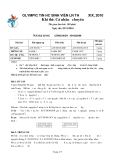
FOURTH INTERNATIONAL COMPETITION
FOR UNIVERSITY STUDENTS IN MATHEMATICS
July 30 – August 4, 1997, Plovdiv, BULGARIA
Second day — August 2, 1997
Problems and Solutions
Problem 1.
Let fbe a C3(R) non-negative function, f(0)=f0(0)=0, 0 < f 00(0).
Let
g(x) = pf(x)
f0(x)!0
for x6= 0 and g(0) = 0. Show that gis bounded in some neighbourhood of 0.
Does the theorem hold for f∈C2(R)?
Solution.
Let c=1
2f00(0). We have
g=(f0)2−2ff00
2(f0)2√f,
where
f(x) = cx2+O(x3), f 0(x) = 2cx +O(x2), f 00(x) = 2c+O(x).
Therefore (f0(x))2= 4c2x2+O(x3),
2f(x)f00(x) = 4c2x2+O(x3)
and
2(f0(x))2qf(x) = 2(4c2x2+O(x3))|x|qc+O(x).
gis bounded because
2(f0(x))2pf(x)
|x|3−→
x→08c5/26= 0
and f0(x)2−2f(x)f00(x) = O(x3).
The theorem does not hold for some C2-functions.
1

Let f(x) = (x+|x|3/2)2=x2+ 2x2p|x|+|x|3, so fis C2. For x > 0,
g(x) = 1
2 1
1 + 3
2√x!0
=−1
2·1
(1 + 3
2√x)2·3
4·1
√x−→
x→0−∞.
Problem 2.
Let Mbe an invertible matrix of dimension 2n×2n, represented in
block form as
M="A B
C D #and M−1="E F
G H #.
Show that det M. det H= det A.
Solution.
Let Idenote the identity n×nmatrix. Then
det M. det H= det "A B
C D #·det "I F
0H#= det "A0
C I #= det A.
Problem 3.
Show that
∞
P
n=1
(−1)n−1sin (log n)
nαconverges if and only if α > 0.
Solution.
Set f(t) = sin (log t)
tα. We have
f0(t) = −α
tα+1 sin (log t) + cos (log t)
tα+1 .
So |f0(t)| ≤ 1 + α
tα+1 for α > 0. Then from Mean value theorem for some
θ∈(0,1) we get |f(n+1)−f(n)|=|f0(n+θ)| ≤ 1 + α
nα+1 . Since P1 + α
nα+1 <+∞
for α > 0 and f(n)−→
n→∞ 0 we get that
∞
P
n=1
(−1)n−1f(n) =
∞
P
n=1
(f(2n−1)−f(2n))
converges.
Now we have to prove that sin (log n)
nαdoes not converge to 0 for α≤0.
It suffices to consider α= 0.
We show that an= sin (log n) does not tend to zero. Assume the
contrary. There exist kn∈Nand λn∈−1
2,1
2for n > e2such that log n
π=
kn+λn. Then |an|= sin π|λn|. Since an→0 we get λn→0.
2

We have kn+1 −kn=
=log(n+ 1) −log n
π−(λn+1 −λn) = 1
πlog 1 + 1
n−(λn+1 −λn).
Then |kn+1 −kn|<1 for all nbig enough. Hence there exists n0so that
kn=kn0for n > n0. So log n
π=kn0+λnfor n > n0. Since λn→0 we get
contradiction with log n→ ∞.
Problem 4.
a) Let the mapping f:Mn→Rfrom the space
Mn=Rn2of n×nmatrices with real entries to reals be linear, i.e.:
(1) f(A+B) = f(A) + f(B), f(cA) = cf(A)
for any A, B ∈Mn,c∈R. Prove that there exists a unique matrix C∈Mn
such that f(A) = tr(AC) for any A∈Mn. (If A={aij}n
i,j=1 then
tr(A) = n
P
i=1
aii).
b) Suppose in addition to (1) that
(2) f(A.B) = f(B.A)
for any A, B ∈Mn. Prove that there exists λ∈Rsuch that f(A) = λ.tr(A).
Solution.
a) If we denote by Eij the standard basis of Mnconsisting of elementary
matrix (with entry 1 at the place (i, j) and zero elsewhere), then the entries
cij of Ccan be defined by cij =f(Eji). b) Denote by Lthe n2−1-dimensional
linear subspace of Mnconsisting of all matrices with zero trace. The elements
Eij with i6=jand the elements Eii −Enn,i= 1,...,n−1 form a linear basis
for L. Since
Eij =Eij.Ejj −Ejj.Eij, i 6=j
Eii −Enn =Ein.Eni −Eni.Ein, i = 1,...,n−1,
then the property (2) shows that fis vanishing identically on L. Now, for
any A∈Mnwe have A−1
ntr(A).E ∈L, where Eis the identity matrix, and
therefore f(A) = 1
nf(E).tr(A).
3

Problem 5.
Let Xbe an arbitrary set, let fbe an one-to-one function mapping
Xonto itself. Prove that there exist mappings g1, g2:X→Xsuch that
f=g1◦g2and g1◦g1=id =g2◦g2, where id denotes the identity mapping
on X.
Solution.
Let fn=f◦f◦ ··· ◦ f
|{z }
ntimes
,f0=id,f−n= (f−1)nfor every natural
number n. Let T(x) = {fn(x) : n∈Z}for every x∈X. The sets T(x) for
different x’s either coinside or do not intersect. Each of them is mapped by f
onto itself. It is enough to prove the theorem for every such set. Let A=T(x).
If Ais finite, then we can think that Ais the set of all vertices of a regular
npolygon and that fis rotation by 2π
n. Such rotation can be obtained as a
composition of 2 symmetries mapping the npolygon onto itself (if nis even
then there are axes of symmetry making π
nangle; if n= 2k+ 1 then there
are axes making k2π
nangle). If Ais infinite then we can think that A=Z
and f(m) = m+ 1 for every m∈Z. In this case we define g1as a symmetry
relative to 1
2,g2as a symmetry relative to 0.
Problem 6.
Let f: [0,1] →Rbe a continuous function. Say that f“crosses the
axis” at xif f(x) = 0 but in any neighbourhood of xthere are y, z with
f(y)<0 and f(z)>0.
a) Give an example of a continuous function that “crosses the axis”
infiniteley often.
b) Can a continuous function “cross the axis” uncountably often?
Justify your answer.
Solution.
a) f(x) = xsin 1
x.
b) Yes. The Cantor set is given by
C={x∈[0,1) : x=
∞
X
j=1
bj3−j, bj∈ {0,2}}.
There is an one-to-one mapping f: [0,1) →C. Indeed, for x=
∞
P
j=1
aj2−j,
aj∈ {0,1}we set f(x) =
∞
P
j=1
(2aj)3−j. Hence Cis uncountable.
4

For k= 1,2,... and i= 0,1,2,...,2k−1−1 we set
ak,i = 3−k
6
k−2
X
j=0
aj3j+ 1
, bk,i = 3−k
6
k−2
X
j=0
aj3j+ 2
,
where i=k−2
P
j=0
aj2j,aj∈ {0,1}. Then
[0,1) \C=
∞
[
k=1
2k−1−1
[
i=0
(ak,i, bk,i),
i.e. the Cantor set consists of all points which have a trinary representation
with 0 and 2 as digits and the points of its compliment have some 1’s in their
trinary representation. Thus, 2k−1−1
∪
i=0 (ak,i, bk,i) are all points (exept ak,i) which
have 1 on k-th place and 0 or 2 on the j-th (j < k) places.
Noticing that the points with at least one digit equals to 1 are every-
where dence in [0,1] we set
f(x) =
∞
X
k=1
(−1)kgk(x).
where gkis a piece-wise linear continuous functions with values at the knots
gkak,i +bk,i
2= 2−k,gk(0) = gk(1) = gk(ak,i) = gk(bk,i) = 0,
i= 0,1,...,2k−1−1.
Then fis continuous and f“crosses the axis” at every point of the
Cantor set.
5

![Đề thi sinh viên giỏi toán năm 2010 vòng chung khảo [kèm đáp án]](https://cdn.tailieu.vn/images/document/thumbnail/2013/20130312/leechanhye/135x160/1822144134.jpg)


![Đề thi môn Toán A3 [năm] mới nhất](https://cdn.tailieu.vn/images/document/thumbnail/2011/20110625/tuyphong131/135x160/dethi_k32_nam2_toan_a3_8694.jpg)





















